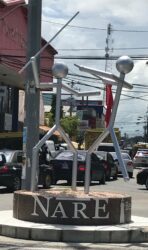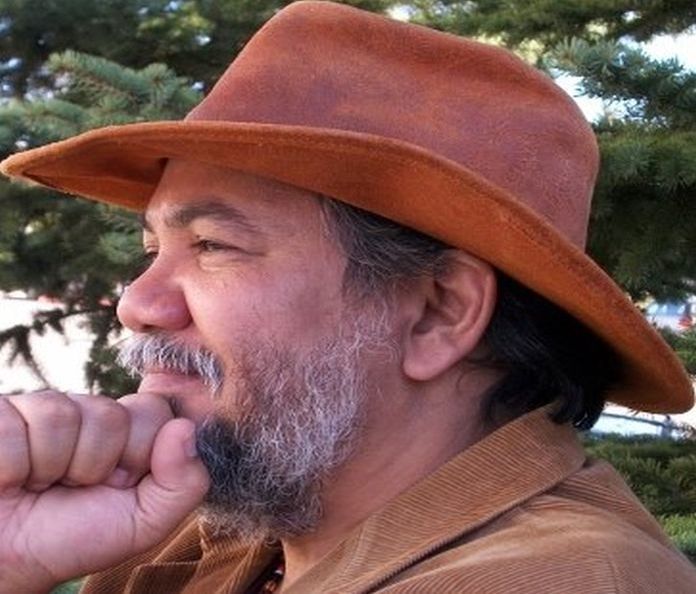By Johnny Coomansingh
This short stick-fighting account might sound jocular, but Pap asked Papito, “Papito yuh ready? Yuh caray?” Papito responded, “yes ah ready!” At that point, Pap did not hesitate to pelt a good bois on Papito. Pap said, “…ah hit him one bois!” That was all that was needed. Papito’s head was busted. The rest is history.
Every time I think of Stick Fighting, a staple in the celebration of the Trinidad pre-Lenten Carnival in Trinidad, I think of him. There he was, slumped on the low steps that protruded from the old Sangre Grande Civic Centre on Brierley Street. With a stick in his hand, blood oozing from a wound on his head, and with sweat pouring down his face, he groaned and grimaced in pain. As a boy of maybe nine or 10 years old, I was just walking by, minding my business, when I saw him. The loading docks of the Sangre Grande Public Transport Service Corporation are now standing on this location.
This lean, brown-skinned man, wearing khaki trousers and a blue shirt seemed to be in intense pain, maybe drunk, maybe confused. His hair, matted from the blood leaking from the cut on his forehead, he began to mumble some unrecognizable words and raised himself to a standing position. I stood there watching his ungainly movements. Continuing with his mumbling and holding the stick over his head, he began to walk around in circles.
It was clear to my little mind that he was dissatisfied with something. My feeling was that he wanted to go back into the stick fighting ring, the gayelle. I did not know much about the activity, but my ears caught the incessant beating of drums and the chanting of songs on the other side of the Civic Centre. For the amount of noise emanating from within, I surmised that a whole lot of people were inside of what I imagined to be the gayelle. I did not go around to investigate. I could not stay to find out what had happened to him. My mother was waiting for her groceries. Subsequent to that observation, and from what I witnessed in Sangre Grande, there was another site where a gayelle was located.
Built opposite the Sangre Grande police station and adjacent to a vacant building lot, there was an old weather-beaten wooden house (Zagabeau’s house) that was probably used as a mini first aid station for damaged stick fighters; stick fighters who got their heads busted by a good bois. Stick fighting in Trinidad and Tobago emerged from the Calinda, a type of dance-like martial art that came with the arrival of Africans who were sold into slavery. Special sticks are chosen from selected trees, for example, the yellow Poui tree.
These sticks sometimes called beau-sticks, measure about an inch in diameter and approximately 30 inches long and are hand-crafted with utmost care. Sticks are treated with a modicum of reverence, sometimes oiled and heated to create the desired hardness. According to tradition, most sticks or bois are mounted, or in other words, “spiritually prepared” by the user or his spiritual agent.

Almost every Saturday the vacant lot became the gayelle (an informal stage or arena; an area/space for challenge and contest) for the stick fighters or bois men who came from Sangre Grande and surrounding districts including Manzanilla, Tamana, Toco, Mayaro, and possibly Biche and Rio Claro. There are stories that many great stick fighters came from Mayaro and Rio Claro. Here they congregate in an area fenced with old and rusty-looking corrugated galvanized steel sheets. The stick-fighting arena or the gayelle was always cordoned off.
A flat charge of maybe two to five dollars was collected as the entrance fee to see the stick fights among the challengers. The noise of the African drums and the chanting would echo through Sangre Grande. Many individuals who did not want to pay to see the fights would find a peep hole in the fence to witness the fervor, the gambage (zesty actions) the sweat, and the blood. As the drumming and chanting nears its crescendo, two valiant dancers, as though in a trance, would enter the ring and start marching around back and forth posturing and sizing up each other like roosters gearing up for a fight.
The drumming and chanting (“Mumma, mumma, yuh son in the grave ahreddy;” “When ah ded bury mih clothes…”) is louder now and suddenly, the sticks violently meet each other, “clataks, clataks, clataks;” the fight commences. The yelling, restless, half-drunk crowd rises with screams and applause, and the bois men, to show their aggression, would leap into the air to gain more presence, more power and agility to “pelt a good bois.”
Winning the battle entails how well an opponent carays, or defends himself with his stick. In many instances, there is a great deal of bloodletting when a bois man wounds his opponent. Large cuts derived from hard wood making contact with the head of the other would open into a gushing stream of blood; time to go to the blood hole to bleed. Some of the wounded would be carried over to Zagabeau’s house for a little treatment and bandages, but the drumming would once more get into them. After drinking a few shots of rum, they would jump back into the ring, blood or no blood!
Stick fighting in Sangre Grande drew very large crowds. Supporters of certain stick fighters came from all over Trinidad. People gambled. Competitions were staged with stick fighters from all over Trinidad and Tobago. What I remember is that Joe Pringay from Sangre Grande was the best bois man that ever lived in Trinidad. I don’t know if it’s true, but I heard that he fell over a low barrier and drowned in a lagoon on Foster Road in Sangre Grande. So sad. Nevertheless, such news did not curtail in any way, the stick-fighting activity in Sangre Grande.





